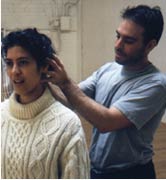 |
||||||||||||||||
|
|
||||||||||||||||
"Turning to the languages of sensation, feeling and perception are fundamental for our survival, health and sanity. They are not self-indulgent distractions, but necessary nourishment for our over-taxed nervous systems." |
Somatic Expressive Practice
“Though we often live unconsciously, every one of us can learn to be awake. It just takes practice. There is only one time when it is essential to awaken. That time is now.” – Buddha “The best political, social, spiritual work we can do is to withdraw the projection of our shadow onto others.” - CG Jung A month after the terrorist attacks, there is an emphasis in the United States on returning to ordinary life. Yet how can we truly return to the life lived prior to 9/11 when we are presently living under “high alert”? In actuality, we are confronted with a different kind of high alert - the alertness of mindfulness and being as aware as we can be in this changing paradigm. This requires learning to master our fear. In these times of uncertainty, it becomes even more important to focus on the life of the body each day in a conscious way. Otherwise, we can all easily become captives of the collective unconscious fear and terror circulating all around. Turning to the languages of sensation, feeling and perception are fundamental for our survival, health and sanity. They are not self-indulgent distractions, but necessary nourishment for our over-taxed nervous systems. Conscious acts of proprioception (body listening) are direct ways to stabilize and soothe the reactive, reptilian brain so we can feel safe in ourselves. This feeling of safety is necessary so our neo-cortical brain can hold paradox and entertain multiple ways of thinking, which it cannot do if the reptile hijacks the self. My life is manageable when I manage myself. When I breathe deeply, lessen my muscular grip, sit back in myself, and step easily forward with inner support, I am able to disorganize automatic stress patterns and soothe my anxiety. I provide new choices for my organism in dealing with what is before me. The situation is the same, yet my perception is not strangled by extraneous tensions; thinking is clearer when tensions are diminished. The ability to receive is enhanced when I am not pre-occupied with my own ruminating. My willingness to reach out and give is heightened when I am feeling well within myself. We are more inclined to open up rather than shut down if we stay in contact with what is alive in us in the present moment. Practices of breath, contact, stillness, vocalization, and movement have been part of spiritual traditions for centuries. We can adapt these ancient technologies anew as contemporary devices for self-remembering. Many of these somatic and expressive practices can even be done in only a few minutes, and circumvent the accumulation of tension with its resulting fatigue. Sprinkled throughout the day, practices are pragmatic, “embodied affirmations” of self-care and renewal. There really is no good reason not to participate in the life of our body. Of course, reason and the best-laid plans can be easily usurped by our moods. Robert Thayer, a psychology professor at UC-San Diego, has been researching mood for the past 25 years. (See Robert Thayer, “Calm Energy” or “The Origin of Everyday Moods”.) He discovered that many people reflexively reach for food, drink, cigarettes, or even chatter, to manage their mood. These strategies are much less effective than self-observation and active interventions, usually in the form of movement activities. A brisk 10-minute walk - his most enduring protocol - was the best mood-manager, transforming “tense-tiredness” to “calm-energy”. (His students also found the same results with singing and dancing for the same amount of time!) Experiment with the somatic practices of self-remembering. Stop throughout the day and be conscious of your breath rhythm. Many different articulations of the breath can bring you back home to yourself. A slow sustained hiss to fully empty your lungs, a yawn to take pressure off of your lower back, a sigh to release your jaw: these are just a few examples. Flex, extend, and rotate your spinal column and let the disks regain their fluidity for shock absorption. Touch yourself gently along the meridian pathways or with compression on pressure points to energize or sedate. Line up your bones in sitting, align yourself with gravity, and smile down your centerline to bring more pleasure and ease. As well as these more contemplative acts of self-remembering, invoke the expressive. Open your mouth and bring out your voice each day. Shake up your body, and dance each day. Self-generated dance and song are vital nutrients for your body and soul. As the Pygmy people say: “If you can walk, you can dance; if you can talk, you can sing.” Whatever practices you choose, keep in mind:
If there is no pleasure in movement, body practices can easily turn into another way to continue the merciless war of self-judgment and non-acceptance. Listen to the language of the fitness world: buns of steel, killer abs, and powerful pecs. Surrounded daily with images of the armored body, steeled for gritty survival - are we shaping our organisms for war or for love? As the 20th Century sage Krishnamurti remarked, “War is but a spectacular expression of our everyday behavior.” Living daily under the shadow of terror and war, anything that we can do to sow the seeds of peace within our own organism, and stop the war at home, is powerful medicine. Copyright 2001 by Jamie McHugh. All rights reserved.
|

Somatic expression workshop. |
||||||||||||||
| © Copyright Jamie McHugh. All rights reserved. About Jamie | What Is Somatic Expression? | Courses | Calendar | Somatic Expression Articles | Somatic Expression Links | Products | Contact Jamie McHugh | Home |
||||||||||||||||